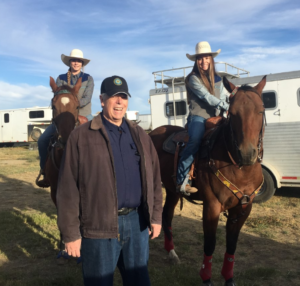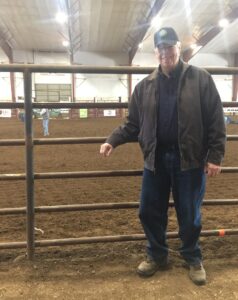Rodeo Coach: Unexpected Responsibilities of an Interim Senior Student Affairs Officer
 Dr. Thomas Corti
Dr. Thomas Corti
Interim Vice President for Student Engagement and Dean of Students
University of Providence (Great Falls, Montana)
In July 2021, Dr. Thomas Corti was named the Registry interim Vice President for Student Engagement & Dean of Students at the University of Providence (UP) in Great Falls, Montana. Shortly after starting this position, Tom was approached about stepping in to coach the University’s Rodeo team. In this brief interview, we visit with Tom to learn how this experience has expanded his perception of what it means to be an interim leader.
Chronicles: What does supervising a Rodeo team from your position actually involve?
Corti: This is the first school I’ve ever worked for that has had Rodeo. UP made the decision before I arrived to move Rodeo from Athletics to Student Engagement. Why? I think it was because Rodeo is not a team sport in NAIA or NCAA. The governing body is the National Intercollegiate Rodeo Association or NIRA.
I work with the coaches and the students in order for them to compete in Rodeo competitions. Rodeo really has two seasons. One in the fall and one in the spring. Each season has 5 Rodeos. When I arrived the students during the school year were boarding their horses at the county fairgrounds. I checked out the facility and found it rather isolated and run down. I talked to people in the area about other options. I was finally able to establish a partnership with a large arena/stable where the students could not only board their horses but also have access to a full-size arena on site to practice. The monthly cost to the university varies based on a number of issues. This past summer Montana had a drought and the price of hay shot up from about $5/bale to around $8.50/bale. Thus, the boarding cost per horse went from $250/month to $325/month.
I handle all the financial aspects as well as the liability issues. For example, at each competition the host school is responsible for an ambulance being on site the entire time the students are competing. If the ambulance leaves to take an emergency call nearby, the Rodeo must stop until the ambulance returns.
Chronicles: Was the program, originally, initiated by UP as an enrollment draw?
Corti: I am not certain of the program’s origin, but we have students from across the state as well as Idaho, North and South Dakota who came because of it. The coaches do actively recruit students for the program. At the present we do not offer scholarships in Rodeo but the university pays all costs related to competing such as their boarding cost, cost of renting a training arena, and travel costs. (Pictured above are Rodeo team members Hailey, riding Titan (right) and Kimberlee (left) riding Tilly.)
Chronicles: From a Student Affairs perspective, do Rodeo team students present an unusual set of challenges for your Office and areas of responsibility?
Corti: Yes, in some ways. With Rodeo, many people do not understand the level of competition. Our student athletes compete with the Big Sky conference. Some of the competitions are 7-8 hours away. It is a major undertaking to haul their horses, unload at the Rodeo site, stable the horses, and saddle up for the competition.
I think from a student affairs perspective, Rodeo really doesn’t receive the attention it needs. Some people think Rodeo is just a bunch of farm/ranch students who enjoy riding. As a student affairs professional, I am constantly evaluating the risk management aspect. This is dangerous sport. The students who ride the bulls and the bucking horses wear helmets and vests. However, injuries routinely occur. And there is a risk in other Rodeo events: hurling yourself off of a galloping horse onto the back of a steer is not easy.
Chronicles: How has supervising this team stretched you as a senior professional?
Corti: It’s a whole new world out there. I’ve had to learn their terminology. For example, I thought the people dressed like clowns were just Rodeo Clowns. No, they are called bull fighters. If you are one of the “clowns” with a barrel, you are called the Barrelman. And collegiate Rodeos have different events than at the professional level. For example, they have a collegiate goat tying competition, which is pretty wild. I didn’t know what this event was until I searched for it on YouTube. So, I have had to spend a lot of time learning about this new sport in addition to everything else.
didn’t know what this event was until I searched for it on YouTube. So, I have had to spend a lot of time learning about this new sport in addition to everything else.
Chronicles: What is a fact or observation about Rodeo teams and their student athletes that our readers might be surprised to learn?
Corti: Although Rodeo is not an NCAA or NAIA sport, the Rodeo students are excellent athletes. Think of the athleticism needed to stay on top of an angry 2,000-pound bull for 8 seconds. People don’t realize how fast these students are competing until you are standing next to the arena rail.
Another interesting fact may be how competitive Rodeo is. Its not unusual for 60 students to compete in the barrel race competition. In fact, some of the students in the barrel racing competition are riding horses that they are borrowing from Rodeo professionals. There’s nothing against that in the rules as long as the rider is eligible to compete.
Chronicles: What is a “lesson learned” about this Rodeo-related experience for you that would be valuable to other Registry Members?
Corti: What I have learned is that we as educators need to be flexible and have the ability to quickly adapt to the environment. I don’t think I could have trained for this. My only past experience was going to Rodeos as a kid growing up in Oregon. My advice is to ask a lot of questions. These students have grown up riding horses all their lives on their families ranch or farm. They know by your questions whether you know anything about Rodeos and riding.
Another lesson learned is, regardless of the sport, to hire good coaches. When I arrived, the Rodeo coach had just resigned and went to one of our competing schools. Fortunately, we hired a fellow who is in the Montana Rodeo Hall of Fame. Our co-coach is his wife who competed professional in Rodeo barrel racing.
Something else I have taken away from this experience is to have fun with it. Don’t pretend you know everything. For example, even if you know how to ride, never ask if you can ride the student’s horse. These horses for the most part are only ridden by one rider. Most horses will balk at a new rider attempting to ride them. In other words, it would not be a pleasant ride. Another thing I learned is how much time it takes to compete in Rodeo. The caring of the horses, taking care of the equipment (tack), the practices, the travel all consume a large part of a student’s time. It is also very expensive. Even though the university takes care of their boarding, competition and transportation costs, most of our Rodeo students estimate it costs them approximately $2,000 a year.
HIRE AN INTERIM
Searching for an Interim?
Please contact us for more information.

